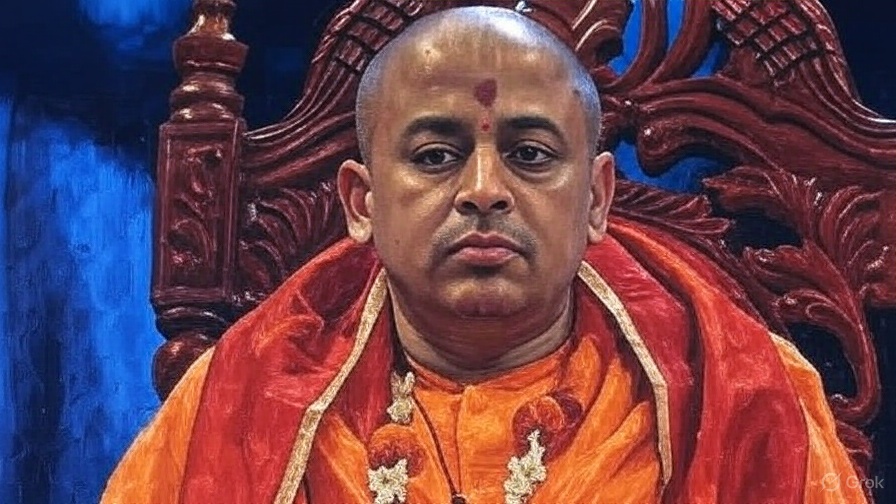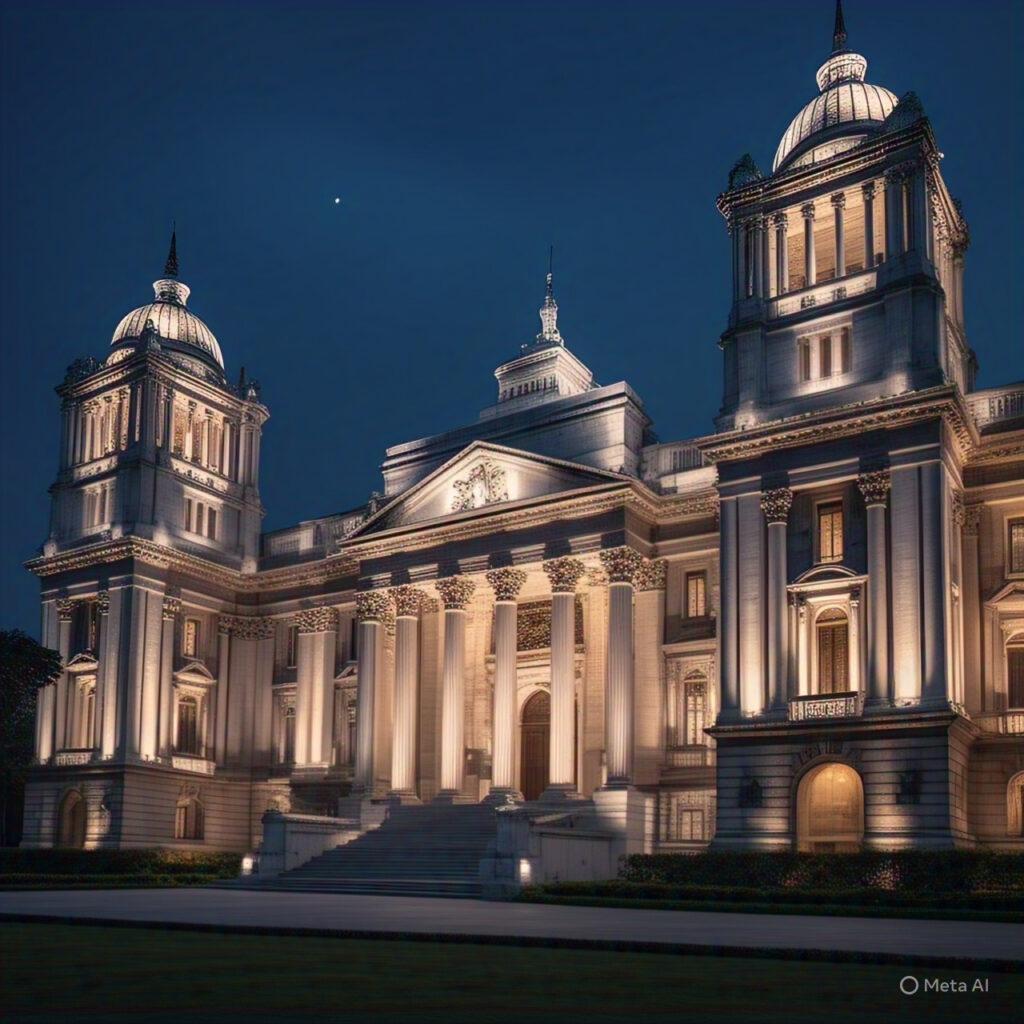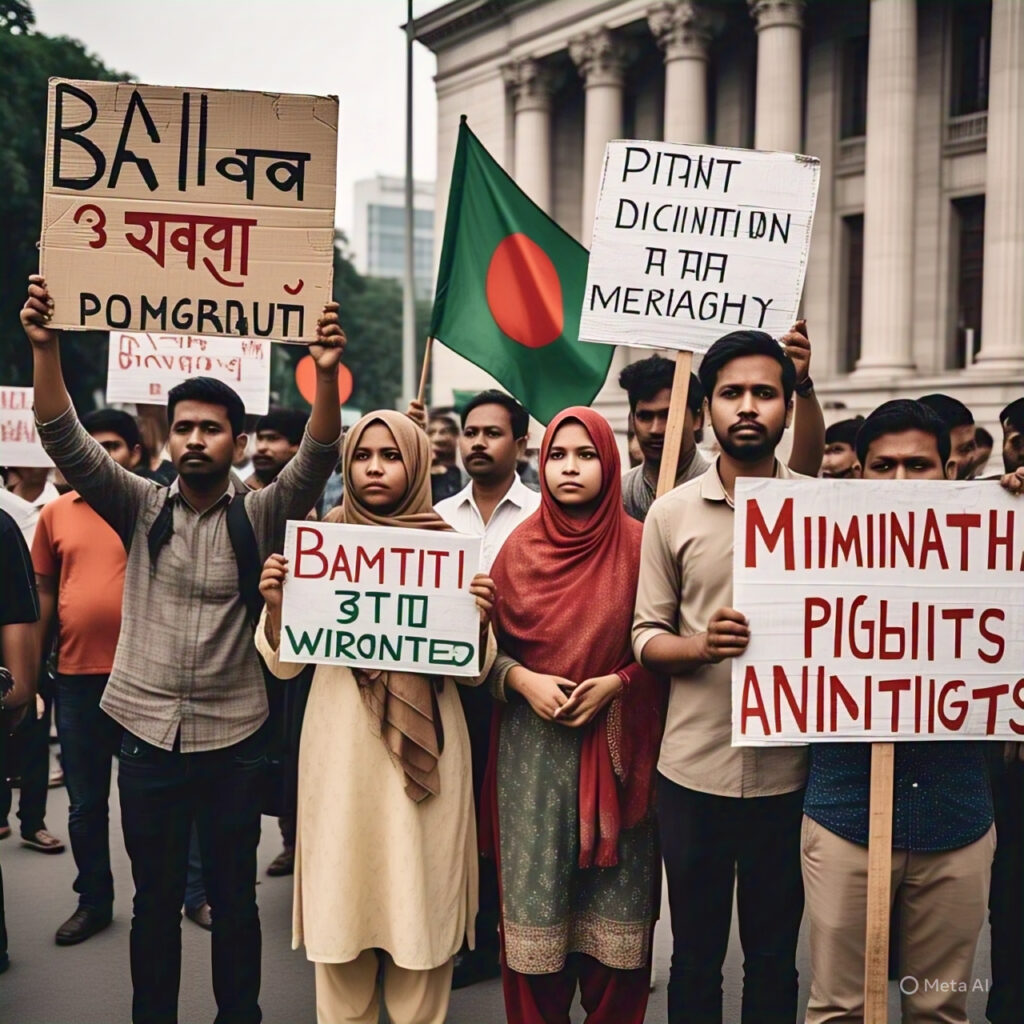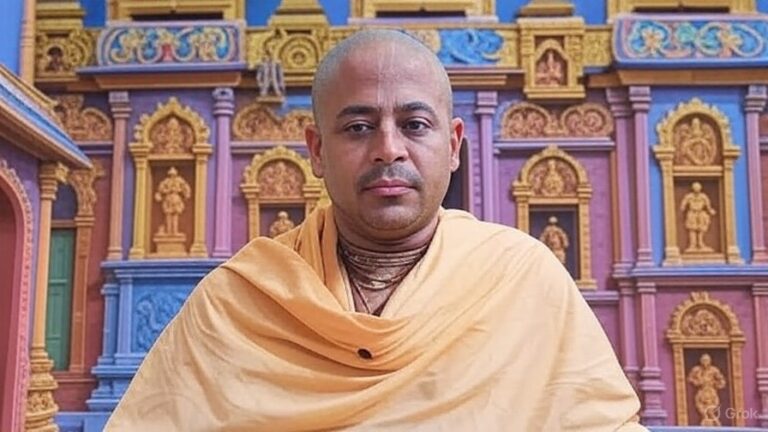What happens when faith, law, and politics collide? That’s exactly what’s unfolding in the ongoing saga of Hindu monk Chinmoy Krishna Das in Bangladesh — a case that’s stirring debates about justice, minority rights, and political power plays.
Curious Reader Question
Have you ever found yourself scouring the internet, piecing together real facts from social noise, just to understand a case that the mainstream headlines barely touch with depth?
After analyzing everything across the internet and gathering real-world insights, the Bhussan.com team shares this friendly, helpful article, breaking down everything you need to know about the Chinmoy Krishna Das Bail Case, without the noise, bias, or confusion. Let’s get into it 👇
Who Is Chinmoy Krishna Das?
Chinmoy Krishna Das isn’t just another name in the religious landscape of Bangladesh — he’s a revered spiritual leader, a teacher, and for many, a symbol of peace and religious resilience. For over two decades, Das has been an active monk and public figure among Bangladesh’s Hindu community, known for conducting bhakti yoga sessions, temple discourses, and interfaith dialogues.

Born in a modest Hindu family in the Sylhet region, Chinmoy Das rose through the spiritual ranks not by power or politics but by the depth of his teachings and his unwavering devotion. He had thousands of followers not just in Bangladesh, but also in India, Nepal, and Sri Lanka. His presence was often seen at peace rallies, cultural events, and community-led harmony initiatives.
He was also vocal about the rising challenges faced by religious minorities in Bangladesh — something that, some believe, made him a target for those who find minority empowerment “inconvenient.”
Why Was He Arrested?
On November 15, 2024, Chinmoy Krishna Das was detained by authorities under controversial charges. According to police reports, he was accused of “hurting religious sentiments” through allegedly inflammatory remarks made during a private spiritual discourse, which was later taken out of context and shared on social media platforms.

Supporters argue the video was doctored, edited maliciously, and distributed by groups aiming to destabilize interfaith relations. Several eyewitnesses claimed that during the session, Das had actually advocated for unity and mutual respect among faiths. However, due to the virality of the clip and pressure from radical elements, the authorities acted swiftly and arrested him.
Critics say his arrest wasn’t just about the video — it was symbolic. “When someone speaks truth to power and raises minority voices, this is what happens,” said one of his disciples. The legal charges, under Bangladesh’s ICT Act and blasphemy-related penal codes, meant that he could face years behind bars if convicted.
The Bail: What the High Court Ruled
After numerous failed attempts at bail and more than 150 days in custody, the Bangladesh High Court finally granted Chinmoy Krishna Das bail on April 24, 2025.
The court found that there was a “lack of substantial evidence” to justify prolonged pretrial detention. In their statement, the judges emphasized the importance of maintaining religious harmony and not letting social media hysteria dictate judicial decisions.
His legal team, led by prominent human rights lawyer Anwar Hossain, argued that his detention was politically motivated, and the state failed to prove any real threat or public disorder caused by Das’s words. The High Court acknowledged the growing concern over misuse of digital laws against religious minorities and underlined the need for “balanced justice.”
It was a major win for the defense, for civil rights groups, and for religious freedom activists who had been demanding his release for months.
Supreme Court’s Intervention: What’s the Catch?
Just when it seemed like Das would finally walk free, a last-minute intervention from the Bangladesh Supreme Court placed a temporary stay on the High Court’s bail order.
On April 28, 2025, the Supreme Court accepted a petition from the state requesting further review of the High Court’s decision. The government claimed that his release could “provoke unrest” and called for more time to examine the evidence.
Legal experts have expressed concern over this stay, calling it “an unfortunate precedent” where freedom granted by one court is suspended on speculative grounds by another. For now, Chinmoy Krishna Das remains in detention, awaiting the Supreme Court’s final hearing scheduled for mid-May.
Timeline: 5 Months of Legal Limbo
-
Nov 15, 2024: Arrested under ICT Act for alleged blasphemy.
-
Nov 18 – Jan 2025: Multiple bail pleas rejected by lower courts.
-
Feb 2025: International human rights groups begin campaigns.
-
Mar 2025: High Court starts formal hearing.
-
Apr 24, 2025: High Court grants bail.
-
Apr 28, 2025: Supreme Court issues stay.
-
May 2025: Final bail hearing expected.
Why This Case Matters to Bangladesh’s Hindu Minority
The arrest and prolonged detention of Chinmoy Krishna Das has become a rallying point for Bangladesh’s Hindu community, which makes up roughly 8% of the population. Historically marginalized, the Hindu minority has often found itself on the defensive when it comes to religious rights, property issues, and political representation.
Activists argue that this case reflects a growing pattern of using digital laws to suppress dissent and target vocal minority figures. The sheer volume of online support, global Hindu organizations speaking out, and peaceful rallies demonstrate that the issue has struck a deep chord.
As one activist said, “This isn’t just about one monk. It’s about whether we, as a nation, can truly claim to support diversity and religious freedom.”
Public Reaction: Social Media, Politicians & Civil Rights Groups
The public response has been explosive. The hashtag #FreeChinmoyDas trended on Bangladeshi and Indian Twitter for over a week. Influencers, journalists, and international civil rights groups joined the chorus calling for justice.

Several prominent politicians criticized the government’s handling of the case. Even some Muslim religious leaders stepped forward to support Das’s right to a fair trial, calling for interfaith unity.
Major civil rights organizations like Amnesty International and Human Rights Watch issued statements condemning the arrest and demanding judicial transparency.
Legal Experts Weigh In
We spoke to three legal experts who provided perspective:
-
Dr. Tanvir Ahmad, constitutional law scholar: “This case tests the spirit of Bangladesh’s secular constitution. The Supreme Court must uphold the principles of justice and not let fear override legality.”
-
Advocate Ruma Chakraborty, human rights attorney: “The bail ruling was strong and fair. Blocking it undermines judicial integrity.”
-
Md. Arif Uddin, criminal lawyer: “We must let courts operate independently. Prolonged detention without conviction violates basic human rights.”
Comparing With Past Similar Cases
This isn’t the first time a religious figure from a minority community has faced legal issues under the ICT Act in Bangladesh.
-
2017: A Buddhist monk was arrested for a misinterpreted Facebook post. Later acquitted.
-
2019: Hindu teacher jailed for months over alleged religious insult — no conviction.
-
2022: Christian pastor briefly detained during a prayer service raid — case dismissed.

These cases show a pattern where accusations often lack proof, yet still result in prolonged imprisonment.
Pros & Cons Table
| Pros | Cons |
|---|---|
| Upholds the right to bail | Supreme Court stay raises questions |
| May inspire minority rights awareness | Case still unresolved |
| High Court’s independence shown | Political tensions deepen |
| Highlights the misuse of ICT laws | Undue delay in justice |
FAQs About the Chinmoy Krishna Das Bail Case🧰
1. Who is Chinmoy Krishna Das and why is he important?
Chinmoy Krishna Das is a respected Hindu monk and spiritual teacher in Bangladesh, known for promoting interfaith harmony. His recent legal case has brought national attention to minority rights and judicial fairness.
2. Why was Chinmoy Krishna Das arrested?
He was arrested on November 15, 2024, for allegedly “hurting religious sentiments” through remarks made in a spiritual discourse — a charge many say is politically motivated and based on doctored video content.
3. What are the exact charges against Chinmoy Krishna Das?
He’s charged under Bangladesh’s Information and Communication Technology (ICT) Act and penal codes related to blasphemy and incitement, though evidence is disputed.
4. What did the High Court decide about his case?
On April 24, 2025, the Bangladesh High Court granted him bail, citing lack of strong evidence and emphasizing judicial independence.
5. Why is he still in jail despite the bail?
Because the Supreme Court issued a stay on the High Court’s bail decision just four days later, pending further review.
6. When is the Supreme Court’s final hearing?
The Supreme Court is expected to hold a final hearing on the matter in mid-May 2025.
7. Is Chinmoy Krishna Das being targeted for his religion?
Many activists and legal experts believe he is being targeted due to his identity as a vocal Hindu monk in a Muslim-majority country.
8. Has this happened to other religious minorities in Bangladesh?
Yes. Similar cases have affected Buddhist monks, Hindu teachers, and Christian pastors, often under digital laws with limited proof.
9. What is the ICT Act in Bangladesh?
The ICT Act governs digital activity but has been criticized for vague language that allows it to be misused against journalists, activists, and minority figures.
10. What does this case mean for religious freedom in Bangladesh?
It highlights the fragility of minority protections and the urgent need for legal reform and stronger safeguards for freedom of expression.
11. Is there international attention on the case?
Yes, organizations like Amnesty International, Human Rights Watch, and global Hindu advocacy groups have voiced concern.
12. Has Chinmoy Krishna Das spoken publicly since his arrest?
No, he has not made public statements. His legal team and followers speak on his behalf.
13. Was the video of his alleged remarks authenticated?
Critics claim the video was edited out of context and lacks credible forensic analysis to prove wrongdoing.
14. What are civil rights groups saying?
They are demanding his immediate release, transparency in legal proceedings, and reform of laws that enable suppression of dissent.
15. How are his followers reacting?
His followers have organized peaceful protests, online campaigns, and prayer vigils, calling the case unjust and politically charged.
16. Are there political motives behind the case?
Many believe so. Critics argue that the arrest was a strategic move to appease hardline factions and discourage minority leaders from speaking out.
17. What role does social media play in the case?
The video that triggered his arrest went viral on social media, prompting outrage from both supporters and opponents — illustrating the double-edged nature of digital platforms.
18. What precedent does this case set?
It sets a troubling precedent where pretrial bail can be overturned without conclusive evidence, raising questions about judicial independence.
19. What happens if the Supreme Court upholds the stay?
Das may remain in jail for months or longer, as his case would proceed to a full trial — something activists warn could take years.
20. Can international bodies intervene?
While they cannot directly intervene in domestic legal matters, sustained international pressure often influences government behavior.
21. How has the media covered the case?
Local coverage has been mixed, with some outlets amplifying state narratives while others highlight minority suppression. International outlets are slowly picking up the story.
22. What are the legal experts saying?
Most legal analysts see the High Court’s bail as sound and the Supreme Court’s stay as concerning, possibly driven more by optics than law.
23. Could Chinmoy Krishna Das be released soon?
It’s possible, depending on the outcome of the upcoming Supreme Court hearing in May 2025.
24. What can supporters do to help?
They can raise awareness, join peaceful advocacy efforts, and support organizations fighting for minority rights and judicial reform.
25. Is there a risk of communal tension because of this case?
Yes, tensions have been reported in parts of Bangladesh, though most protests remain peaceful. Religious leaders urge calm and dialogue.
26. What has the government said officially?
The government argues that the case is about maintaining public order, not about religion or minority suppression.
27. How long has Chinmoy Krishna Das been in custody?
As of May 2025, he has been in custody for nearly six months.
28. Has there been any political backlash?
Yes, opposition politicians and civil society members have criticized the government for mishandling the case and stifling religious freedom.
29. Are there petitions or campaigns for his release?
Yes, multiple online petitions have been launched, and global human rights groups are running coordinated campaigns for his release.
30. What is the public sentiment in Bangladesh?
It’s polarized — with many supporting his release and others, influenced by misinformation, demanding strict action.
31. Is his case unique?
Unfortunately, no. It fits a broader pattern of religious leaders and activists being silenced under ambiguous digital laws.
32. Could this case lead to legal reform?
Possibly. Growing civil outcry and international attention may push lawmakers to revisit the ICT Act and related penal codes.
Conclusion: What Happens Now?📌
The story of Chinmoy Krishna Das isn’t over. While the High Court’s ruling was a victory for justice, the Supreme Court’s stay has reignited concerns over political pressure and legal inconsistency.
What happens next? That depends on whether the Supreme Court can rise above political noise and uphold the constitution’s promise of fairness.
Until then, Das remains behind bars. But his case has sparked something larger — a movement, a conversation, and perhaps, a reckoning.
If you care about justice and minority rights, now’s the time to speak, share, and stay informed.
You can follow updates through human rights organizations, regional news outlets, and trusted sources platforms like Bhussan.com that provide unbiased, in-depth analysis.
Recommended Outbound Links (to insert in the content):
-
Bangladesh High Court Info
Link from official source
🔗 Bangladesh Supreme Court Website
Place this in the section: “The Bail: What the High Court Ruled” - ICT Act Full Text
🔗 Bangladesh ICT Act – Government PDF
Place this in the section: “What is the ICT Act in Bangladesh?”

